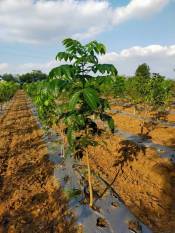NEW DELHI, 5 May 2024: Mahogany, a prized timber renowned for its rich color, exceptional strength, and enduring beauty, has long been a cornerstone of the global furniture industry.
However, concerns about deforestation have led to a shift towards sustainable cultivation. In India, mahogany farming is emerging as a promising avenue for farmers seeking a lucrative and eco-friendly option. This report explores the potential benefits, challenges, and strategies for Indian farmers to capitalize on the growing demand for sustainably sourced mahogany.
A Golden Opportunity: The Benefits of Mahogany Cultivation
For farmers willing to invest in the long term, mahogany cultivation offers a compelling set of advantages:
- High Market Value: Mature mahogany trees can fetch significant returns, with prices ranging from Rs. 2,000 to Rs. 5,000 per cubic foot. A single well-maintained tree can generate substantial revenue after 15-20 years.
- Relatively Low Maintenance: Once established, mahogany trees are fairly resilient, thriving in well-drained soils with moderate rainfall. This allows for intercropping with other crops in the initial years, providing additional income.
- Increased Land Value: Mahogany plantations significantly enhance the value of farmland over time. This not only benefits long-term financial planning but also creates a valuable asset for loan applications.
A Geographical Dance: Where Mahogany Flourishes
India's diverse climate allows for mahogany cultivation across several states, with specific regions offering optimal conditions:
- Southern Sojourn: States like Kerala, Karnataka, and Tamil Nadu, with their tropical climate and well-established forestry practices, are leading producers of high-quality mahogany.
- Central Hub: Madhya Pradesh, Maharashtra, and Chhattisgarh boast suitable soil conditions and ample rainfall, making them ideal contenders for mahogany cultivation.
- Western Ghats Advantage: The states along the Western Ghats, like Goa and Maharashtra, benefit from the region's high rainfall and fertile soil, leading to excellent mahogany growth.
Government Support: Nurturing a Sustainable Future
The Indian government recognizes the potential of mahogany farming and offers support through various schemes:
- Subsidies and Incentives: Programs like the National Mission on Sustainable Agriculture (NMSA) provide financial assistance for planting trees, including mahogany, on a per-hectare basis.
- Technical Support: Government forestry departments offer technical guidance and training to farmers on best practices for mahogany cultivation, ensuring sustainable management.
The Global Market Beckons: Can Indian Farmers Become Major Players?
The global market for mahogany is estimated to reach USD 14.5 billion by 2027, driven by a growing demand for sustainable and ethically sourced wood. Here's how Indian farmers can position themselves for disruption:
- Quality Focus: Implementing stringent quality control measures ensures a consistent and high-grade product, fetching premium prices in the international market.
- Sustainability Certifications: Obtaining certifications like Forest Stewardship Council (FSC) demonstrates responsible sourcing practices and attracts environmentally conscious buyers.
- Value Addition: Exploring avenues like furniture-making or veneer production from mahogany can create a diversified revenue stream and higher profit margins.
Challenges and Considerations: A Measured Approach
Despite its attractive potential, mahogany farming comes with its own set of challenges:
- Long Gestation Period: The wait for mature trees (15-20 years) demands patience and careful financial planning to ensure a steady income stream during the interim.
- Land Availability: Large-scale mahogany cultivation requires significant land area, which might be a constraint for some farmers.
- Market Fluctuations: Global mahogany prices can fluctuate depending on economic factors and competition from other producing countries. Diversifying with other crops can mitigate this risk.
Mahogany farming presents a unique opportunity for Indian farmers to generate wealth while contributing to environmental sustainability.
By leveraging government support, focusing on quality and responsible practices, and exploring value addition, Indian farmers have the potential to become major players in the global mahogany market. However, success necessitates a long-term vision, a commitment to sustainable practices, and a keen understanding of market dynamics. By embracing these principles, Indian mahogany can become a golden crop, ensuring a prosperous and eco-friendly future for farmers and the nation.




















